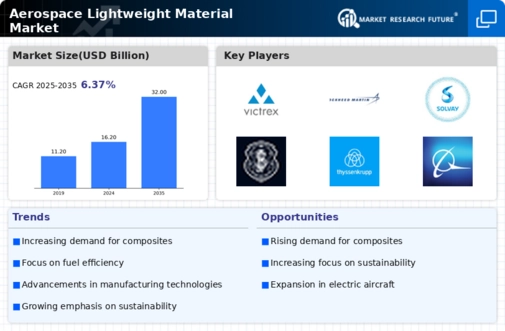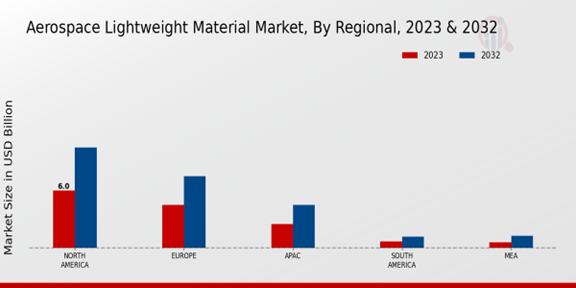Rising Commercial Aviation Sector
The expansion of the commercial aviation sector is a pivotal driver for the Global Aerospace Lightweight Material Market Industry. As air travel continues to grow, airlines are investing in new aircraft that utilize lightweight materials to enhance operational efficiency. The International Air Transport Association projects a steady increase in passenger numbers, which necessitates the development of more fuel-efficient aircraft. Consequently, manufacturers are focusing on lightweight materials to meet this demand. This trend is expected to significantly contribute to the market's growth trajectory, as airlines seek to optimize their fleets and reduce operational costs.
Growing Demand for Fuel Efficiency
The Global Aerospace Lightweight Material Market Industry is experiencing a notable surge in demand driven by the imperative for fuel efficiency in aviation. Airlines and manufacturers are increasingly adopting lightweight materials to reduce aircraft weight, which directly correlates with fuel consumption. For instance, the integration of lightweight composites and alloys can lead to a reduction in fuel usage by approximately 20 to 30 percent. This trend is expected to contribute to the market's growth, with projections indicating a market value of 16.2 USD Billion in 2024, potentially doubling to 32.0 USD Billion by 2035, reflecting a compound annual growth rate of 6.37% from 2025 to 2035.
Increased Investment in Aerospace R&D
Investment in research and development within the aerospace sector is a crucial factor influencing the Global Aerospace Lightweight Material Market Industry. Governments and private entities are allocating substantial resources to explore new lightweight materials and their applications in aerospace. This focus on R&D is fostering innovation and the development of advanced materials that can withstand the rigorous demands of aerospace environments. As a result, the market is likely to see a proliferation of novel materials that enhance performance and reduce weight, thereby driving growth in the industry.
Regulatory Pressure for Emission Reductions
The Global Aerospace Lightweight Material Market Industry is also shaped by increasing regulatory pressure aimed at reducing greenhouse gas emissions. Governments worldwide are implementing stringent regulations that mandate lower emissions from aircraft. This regulatory environment compels manufacturers to seek lightweight materials that contribute to lower fuel consumption and, consequently, reduced emissions. For instance, the European Union's commitment to achieving net-zero emissions by 2050 is pushing aerospace companies to innovate and adopt sustainable practices. This regulatory landscape is expected to bolster the demand for lightweight materials, further propelling market growth.
Technological Advancements in Material Science
Innovations in material science are significantly influencing the Global Aerospace Lightweight Material Market Industry. Advanced manufacturing techniques, such as 3D printing and nanotechnology, are enabling the development of new lightweight materials that offer enhanced performance characteristics. For example, the use of carbon fiber reinforced polymers is becoming more prevalent due to their superior strength-to-weight ratio. These advancements not only improve the structural integrity of aircraft but also facilitate the production of complex geometries that were previously unattainable. As these technologies mature, they are likely to drive further adoption of lightweight materials in aerospace applications.




















Leave a Comment